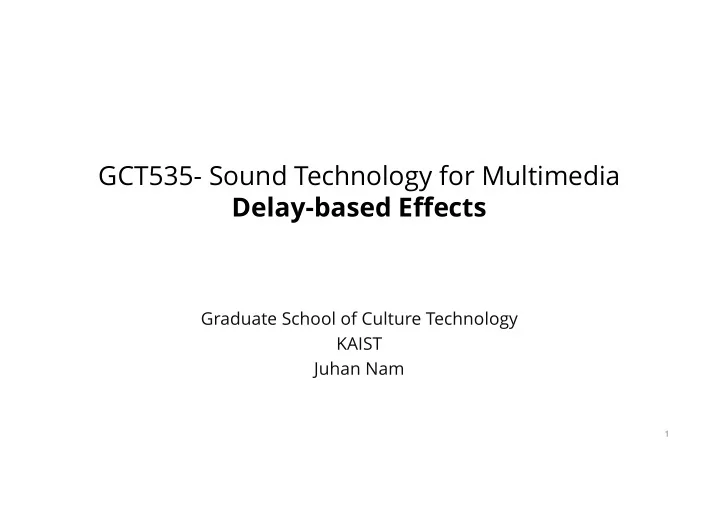

GCT535- Sound Technology for Multimedia Delay-based Effects Graduate School of Culture Technology KAIST Juhan Nam 1
Delay-based Audio Effects § Types of delay-based audio effect – Delay – Chorus – Flanger – Reverberation (this will be handled in the topic of spatial audio effect ) 2
Comb Filter + + 𝑦 𝑜 𝑧 𝑜 𝑦 𝑜 𝑧 𝑜 𝑨 +, 𝑨 +0 𝑧 𝑜 = 𝑦 𝑜 + ' 𝑦 𝑜 − 𝑁 𝑧 𝑜 = 𝑦 𝑜 + ' 𝑧(𝑜 − 𝑂) IIR Comb FIlters FIR Comb Filter – Implemented by circular buffer: move read and write pointers instead of shift all samples in the delayline 3
Comb Filter: Frequency Response § ”Combs” become shaper in the feedback type 𝑧 𝑜 = 𝑦 𝑜 + 𝑦(𝑜 − 8) 𝑧 𝑜 = 𝑦 𝑜 + 0.9 ' 𝑧(𝑜 − 8) 4
Perception of Time Delay § The 30 Hz transition – Given a repeated click sound (e.g. impulse train): • If the rate is less than 30Hz, they are perceived as discrete events. • As the rate is above 30 Hz, they are perceive as a tone – Demo: http://auditoryneuroscience.com/?q=pitch/click_train § Feedback comb filter: 𝑧 𝑜 = 𝑦 𝑜 + 𝑏 ' 𝑧(𝑜 − 𝑂) 8 – If N < :; ( 𝐺 > : sampling rate): change tone of the input sound 9 • If N is large under this condition, it can generate a pitched tone as it models sound propagation and reflection on a string (e.g. Karplus-Strong model) 8 – If N > :; ( 𝐺 > : sampling rate): repeat discrete events with gain loss 9 5
Fractional Delay § Necessary when the length of delay continuously changes – Chorus, flanger and other modulations fractional delay (= 𝑒 ) 𝑁 − 1 𝑁 𝑁 + 1 . . . 𝑦 𝑜 𝑦 𝑜 − 𝑁 − 𝑒 6
Linear Interpolation 1 − 𝑒 𝑨 +, 𝑨 +B 𝑦 𝑜 + 𝑧 C 𝑜 − 𝑒 𝑧 𝑜 𝑒 𝑧 C 𝑜 − 𝑒 = (1 − 𝑒) ' 𝑧 𝑜 + 𝑒 ' 𝑧(𝑜 − 1 ) § The output is delayed approximately by 𝑒 – The phase delay in the low frequency range is close to the fractional delay 𝑒 – The output is attenuated in the high frequency range – Useful in “random access mode” (no recursion) 7
Linear Interpolation § Frequency Response https://ccrma.stanford.edu/~jos/pasp/Fractional_Delay_Filtering_Linear.html 8
First-Order Allpass Interpolation Allpass Filter 𝑏 𝑨 +, 𝑨 +B 𝑦 𝑜 + + 𝑧 C 𝑜 − 𝑒 𝑥 𝑜 𝑧 𝑜 −𝑏 𝑥 𝑜 = 𝑧 𝑜 − 𝑏 ' 𝑥(𝑜 − 1 ) 𝑒 = 1 − 𝑏 𝑧 C 𝑜 − 𝑒 = 𝑏 ' 𝑥 𝑜 + 𝑥(𝑜 − 1 ) 1 + 𝑏 § The output is delayed approximately by 𝑒 – The phase delay in the low frequency range is close to the fractional delay 𝑒 – The output is unity at all frequency range – Be careful in “random access mode” 9
First-Order Allpass Interpolation § Frequency Response https://ccrma.stanford.edu/~jos/pasp/First_Order_Allpass_Interpolation.html 10
Delay Effect + 𝑦 𝑜 Delay Line feedback Wet Dry 𝑧 𝑜 + § Generate repetitive loop delay – Parameters • Feedback gain • Delay length – Ping-pong delay: cross feedback between left and right channels in stereo – The delay length is often synchronized with music tempo 11
Chorus Effect LFOs Delay Line x(n) + Wet Dry y(n) + § Gives the illusion of multiple voices playing in unison – By summing detuned copies of the input – Low frequency oscillators (LFOs) are used to modulate the position of output tops • This causes pitch-shift 12
Flanger Effect LFOs Delay Line x(n) Static tap Variable tap + Wet Dry y(n) + § Emulated by summing one static tap and variable tap in the delay line – “Rocket sound” – Feed-forward comb filter where harmonic notches vary over frequency. – LFO is often synchronized with music tempo 13
Recommend
More recommend